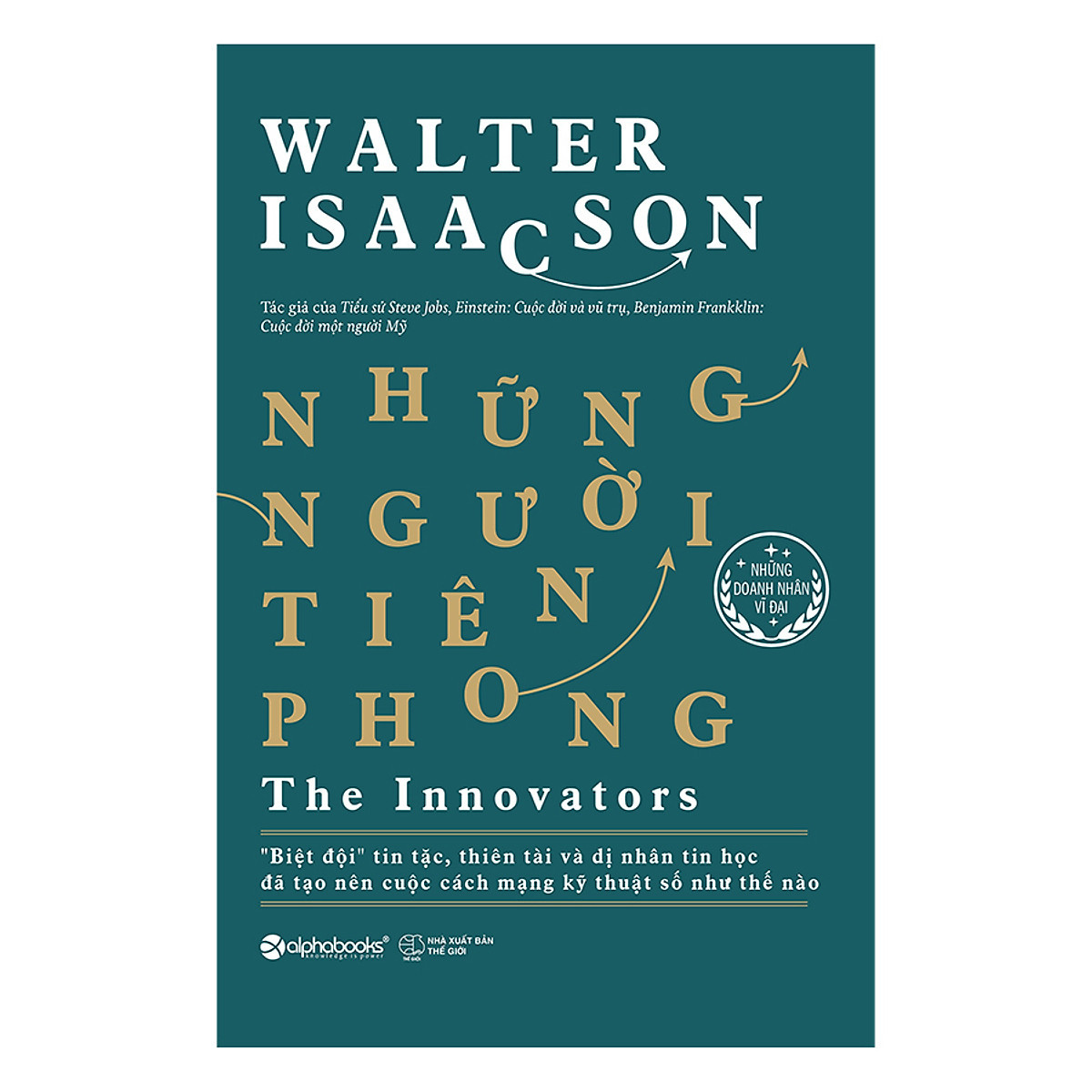Người ta hay hiểu nhầm rằng những phát minh và công trình vĩ đại là nhờ ý tưởng và công sức của một nhà khoa học nào đó sống lay lắt trên tầng gác mái hay hầm gara. Tuy nhiên, “hầu hết các phát minh của thời đại kĩ thuật số đều được tạo ra qua con đường hợp tác với sự tham gia của rất nhiều nhân vật thú vị.” Đó là những “biệt đội” tin tặc, thiên tài và dị nhân tin học, những người đứng sau cuộc cách mạng công nghệ kĩ thuật đang từng ngày từng giờ thay đổi cuộc sống của chúng ta. Mặc dù ngày nay, hầu như mọi người đều tiếp cận máy tính và Internet, nhưng không mấy ai biết đến họ.
“Một thiên sứ vĩ đại và cảm động về thời đại kĩ thuật số. Hấp dẫn và giàu giá trị, một lần nữa, tài năng kể chuyện “ngoại hạng” của Isaacsson đã được phô bày trọn vẹn để độc giả chiêm ngưỡng. Cùng chủ đề, các tác giả khác chỉ chú trọng vào việc phiên dịch các thuật ngữ kĩ thuật hay tập trung vào khai thác khía cạnh tính ngạo mạn và thói tham lam đã khiến các thiên tài thất bại như thế nào, nhưng cuốn sách này khiến chúng ta không thể rời mắt vì đã được viết bởi lòng đam mê thuần khiết. Bởi vậy, đây là cuốn sách đáng đọc nhất không chỉ vì các kiến giải phức tạp đối với các phát minh gây chấn động lịch sử hay các tấn kịch thương trường theo sau chúng, mà chính là vì những khoảng lặng. Những khoảng lặng mà qua đó chúng ta nhận ra rằng, động lực sâu xa nhất đối với “những kẻ tiên phong” không gì khác ngoài niềm vui bình dị của sự sáng tạo.” – The New York Times.
Walter Isaacson là một nhà báo, nhà văn nổi tiếng. Ông sinh ngày 20 tháng Năm năm 1952 tại New Orleans, Louisiana. Ông từng giữ chức Chủ tịch và CEO của Học viện Aspen - một tổ chức nghiên cứu giáo dục và chính sách phi đảng phái, và từng là giảng viên môn lịch sử tại Đại học Tulane. Hiện tại, Isaacson đang là Chủ tịch Hội đồng quản trị và CEO của CNN, đồng thời là chủ bút của tờ Time. Ông là tác giả của các cuốn sách ăn khách như Tiểu Sử Steve Jobs, Einstein: Cuộc Đời Và Vũ Trụ & Benjamin Franklin: Cuộc Đời Một Người Mỹ. Isaacson bắt đầu viết Những Người Tiên Phong từ một thập kỉ trước với niềm đam mê những tiến bộ của thời đại kĩ thuật số và mong muốn “chú trọng đến vai trò có tính quyết định của kĩ năng làm việc nhóm”, liên kết các lực lượng cá nhân và văn hóa khác nhau tham gia vào quá trình sáng tạo đổi mới.
Ban đầu, Những Người Tiên Phong được dự định viết tập trung vào các nhóm tạo ra Internet nhưng Bill Gates đã thuyết phục Isaacson nên “nhìn vào sự xuất hiện đồng thời của Internet và máy vi tính cá nhân”. Ông ngừng viết cuốn sách vào đầu năm 2009 để tập trung vào thực hiện tiểu sử của Steve Jobs, và chính câu chuyện của ông hoàng công nghệ này lại khiến ông quan tâm nhiều hơn đến mối gắn kết giữa Internet và máy vi tính. Isaacson đã đi theo gợi ý của Bill Gates và xuất bản Những Người Tiên Phong vào tháng Mười năm 2014.
Hai yếu tố
Những Người Tiên Phong nêu bật hai yếu tố quan trọng nhất trong việc tìm hiểu quá trình hình thành cuộc cách mạng công nghệ hiện nay. Đó là sáng tạo tập thể và kết nối nghệ thuật – khoa học.
“Cuốn sách này sẽ kể về cách thức họ phối hợp với nhau, đồng thời lý giải tại sao khả năng làm việc nhóm lại giúp họ trở nên sáng tạo hơn nữa.” Mặc dù sáng tạo tập thể được đánh giá là yếu tố quan trọng nhưng trên thực tế, có rất ít sách đề cập đến vấn đề này. Người ta hay viết và (có lẽ là) ưa chuộng những câu chuyện về từng cá nhân xuất chúng hơn. Bằng chứng là nếu bạn tìm kiếm cụm từ “the man who invented” trên Amazon, 1.860 kết quả về sách sẽ hiện ra.
Tôi rất ngạc nhiên khi nhận thấy những sáng tạo đích thực của thời đại kĩ thuật số lại đến từ những con người có khả năng kết nối giữa nghệ thuật và khoa học. Họ tin vào tầm quan trọng của cái đẹp. (…) Những con người có thể thoải mái đứng ở giao điểm giữa nhân văn và công nghệ này đã góp phần tạo nên mối quan hệ cộng sinh giữa con người và máy móc, và họ cũng là trọng tâm của cuốn sách này.
Những người tiên phong
Xin nhớ rằng Những Người Tiên Phong bao gồm rất nhiều những con người xuất chúng và tài giỏi đã tham gia vào quá trình hình thành cuộc cách mạng công nghệ. Với độ dày hơn 600 trang, số lượng người được nhắc đến không cho phép tôi liệt kê toàn bộ họ ra ở đây. Bởi vậy, xin phép được đề cập một vài người mà theo tôi là thú vị và quan trọng. Tư tưởng và công việc của những người được đề cập dưới đây, theo tôi, đóng vai trò bước ngoặt trong quá trình chế tạo máy tính và dẫn đến kỉ nguyên công nghệ như hiện nay.
Trong lĩnh vực máy vi tính, người hiện thân cho sự giao thoa giữa nghệ thuật và khoa học – yếu tố thứ hai được nói đến phía trên – là một người phụ nữ. Ada Byron, hay Ada Lovelace, nữ bá tước xứ Lovelace và con gái hợp pháp duy nhất của thi hào George Gordon Byron đã đem lòng yêu mến thứ mà cô gọi là “nền khoa học nên thơ”. Ngay từ cách gọi tên đã thấy Ada là một trong những đại diện của kết nối nghệ thuật và khoa học. Ada thừa hưởng vẻ lãng mạn thơ ca từ người cha cô chưa một lần được gặp mặt, “một phẩm chất mà mẹ cô đã cố gắng kiềm chế bằng cách cho cô học thêm môn toán.” Tình yêu dành cho cả thơ ca và toán học đã giúp Ada nhìn thấy vẻ đẹp trong một cỗ máy tính. “Cô chính là một hình mẫu của kỉ nguyên khoa học lãng mạn.”
Khả năng nhận thức vẻ đẹp toán học của Ada là một tài năng vượt quá sự hiểu biết của nhiều người, bao gồm cả những người tự cho mình là tri thức. Ada nhận ra toán học là là một ngôn ngữ đáng yêu, thứ ngôn ngữ miêu tả sự hài hòa của vũ trụ và đôi khi cũng khá thi vị. Bất chấp những nỗ lực của mẹ, cô vẫn là con gái của cha mình, sự nhạy cảm thơ ca cho phép cô mường tượng về một phương trình như một nét cọ phác ra một góc vẻ đẹp lộng lẫy về mặt vật lý của tự nhiên, cũng giống như việc cô có thể hình dung ra “đại dương có màu rượu u tối” hay một người phụ nữ “bước đi trong nhan sắc, giống như màn đêm”.
Đóng góp quan trọng của Ada trong lĩnh vực máy tính là bảng phụ chú hỗ trợ giải thích Máy Giải tích của Charles Babbge, được đăng kèm bản dịch của cô cho bài viết về cỗ máy của Luigi Menabrea. “Nó được hoàn thành với 19.136 từ, dài gấp đôi bài viết gốc của Menabrea. (…) không lâu sau nó trở nên nổi tiếng hơn cả bài báo gốc, và nó giúp cô trở thành một nhân vật biểu tượng trong lịch sử tin học.”
Trong phần phụ chú, Ada khẳng định rằng máy móc không thể tư duy. Cô viết “Máy Giải tích không có ý định khởi tạo ra bất kì điều gì. Nó có thể làm bất cứ điều gì nếu chúng ta biết cách ra lệnh cho nó thực hiện. Nó có thể thực hiện các phân tích, nhưng nó không hề có năng lực dự đoán bất kì mối liên hệ mang tính phân tích hay chân lý nào cả.” Nhà tiên phong về máy vi tính, Alan Turing đã đặt tên lời khẳng định này là “Sự phản bác của phu nhân Lovelace.”
Trên thực tế, những đóng góp của Ada vừa sâu sắc lại vừa đầy cảm hứng. Hơn cả Babbage hay bất kì cá nhân nào khác trong thời đại của mình, bà đã nhìn thấy trước một tương lai trong đó máy móc sẽ trở thành đối tác của trí tưởng tượng con người, cùng con người dệt nên những tấm thảm đẹp như những sản phẩm được tạo ra từ chiếc máy dệt Jacquard. Sự trân trọng nền khoa học nên thơ đã khiến bà ca tụng một chiếc máy tính toán đã bị nền khoa học chính thống đương thời bác bỏ, và bà đã hiểu có thể vận dụng sức mạnh xử lý của một thiết bị như vậy đối với bất kì thông tin nào. Như vậy, Ada, Nữ bá tước xứ Lovelace đã góp phần gieo những hạt giống cho một thời đại kĩ thuật số sẽ đơm hoa kết trái sau đó 100 năm.
100 năm sau bài viết về Máy Giải tích, các phương pháp tiếp cận, những công nghệ và lý thuyết mới bắt đầu xuất hiện. “Năm 1937 trở thành một năm kì tích của thời đại máy vi tính với thành tựu là sự lên ngôi của bốn khái niệm có mối tương quan tương đối với nhau, và cũng là những yếu tố sẽ định nghĩa nên ngành tin học hiện đại.”
Bốn khái niệm đó bao gồm:
- Kỹ thuật số: những tiến bộ đồng thời về lý thuyết logic học, các bảng mạch và những bộ chuyển mạch đóng mở điện tử đã góp phần giúp phương pháp kỹ thuật số gặt hái được nhiều thành quả hơn so với kĩ thuật tương tự.
- Nhị phân: hệ đếm chỉ sử dụng hai số 0 và 1, lý thuyết nhị phân được Leibniz tiên phong vào cuối thế kỷ XVII.
- Điện tử: sử dụng các thành phần điện tử như đèn chân không, và sau này là bóng bán dẫn và vi mạch, máy vi tính có thể vận hành nhanh hơn gấp hàng nghìn lần so với những cỗ máy dùng các bộ chuyển mạch điện cơ có thành phần chuyển động.
- Đa chức năng: máy vi tính có khả năng giải được không chỉ một dạng phép toán, mà còn có thể xử lý được vô số nhiệm vụ và các thao tác ký hiệu, bao gồm chữ viết, âm nhạc, hình ảnh, con số.
Có một cách nhìn nhận về sự sáng tạo là coi đó như sự tích lũy của hàng trăm tiến bộ nhỏ lẻ. (…) Nền tảng cho tất cả những tiến bộ này là một số bước nhảy tuyệt vời – mà hẳn Ada sẽ gọi là nên thơ – của toán học. Một trong số những bước nhảy này đã dẫn đến khái niệm chính thức về một chiếc “máy vi tính vạn năng”, một cỗ máy đa năng có thể được lập trình để thực hiện bất kì nhiệm vụ logic nào và mô phỏng hành vi của bất kì cỗ máy logic nào khác.
“Theo hình dung của Ada Lovelace và Alan Turing, một chiếc máy vi tính thực thụ phải có khả năng thực hiện một cách thuần thục và nhanh chóng bất kì phép toán logic nào.” Điều này đòi hỏi các cỗ máy phải được điều hành bằng cả phần cứng và phần mềm. Như vậy, công việc tìm cách lưu trữ các chương trình trong bộ nhớ điện tử của máy, lập trình, bắt đầu được tiến hành với chiếc máy Mark I và Grace Hopper là nhân vật đại diện.
Khi những người đàn ông phát minh ra máy vi tính đều tập trung chủ yếu vào phần cứng, những người phụ nữ lại sớm nhận ra tầm quan trọng của lập trình. “Nhà lập trình tiên phong thú vị nhất là Grace Hopper.” Bà sinh năm 1906 trong một gia đình giàu có ở khu Thượng Tây Manhattan. Bà là một nữ sĩ quan hải quân dũng cảm, nhiệt huyết nhưng cũng rất lôi cuốn và thân thiện. Hopper là người phụ nữ thứ 11 nhận bằng Tiến sĩ toán học tại Yale. Sau khi tốt nghiệp trường Sĩ quan Dự bị của hải quân tại Đại học Smith, Massachusetts vào tháng Sáu năm 1944, bà được lệnh đến Đại học Harvard để làm việc với cỗ máy vi tính kĩ thuật số khổng lồ Mark I được thiết kế bởi Howard Aiken năm 1937. Grace Hopper được Aiken giao nhiệm vụ viết một cuốn sách nhờ có khả năng truyền đạt chính xác. Cuốn sách 500 trang với nội dung kể về lịch sử chiếc máy Mark I và hướng dẫn lập trình sau này trở thành cuốn cẩm nang hướng dẫn lập trình máy vi tính đầu tiên trên thế giới.
Giống như Grace Hopper, những người phụ nữ của ENIAC (máy tích hợp điện tử và máy tính – chiếc máy tính mạnh nhất và nổi tiếng nhất ra đời từ Thế chiến II) đã nhanh chóng chứng tỏ việc lập trình một chiếc máy vi tính cũng quan trọng như việc chế tạo phần cứng của nó. Và về sau, nam giới cũng đã nhận ra điều này. Hồi đó họ vẫn còn quá coi trọng phần cứng và không quan tâm đến các phần còn lại của máy tính.
Cảm nhận cá nhân
Những Người Tiên Phong chắc chắn dành cho những người có mong muốn tìm hiểu những lý do tạo nên cuộc cách mạng kĩ thuật số. Walter Isaacson đã đem đến cho chúng ta cả một lịch sử về máy tính, từ những bước chế tạo đầu tiên đến sự bùng nổ Internet. Tất cả đóng góp được kể và miêu tả qua 623 trang sách. Lượng thông tin quá khổng lồ. Nhưng với những người muốn biết rõ về kỉ nguyên công nghệ, cuốn sách này là một tài liệu cần phải có.
Bài review này chỉ có thể cung cấp một góc nhìn vào một vài thời điểm chế tạo máy tính. Số lượng người tạo nên bước ngoặt không chỉ có những người tôi đã đề cập bên trên. Sẽ còn những cái tên khác, những cái tên nổi bật hơn xuất hiện. Từng đóng góp, từng phát minh và từng chế tạo, từng tư duy của họ đều đang thay đổi thế giới.
Công cuộc cách tân đến từ những người có thể liên kết cái đẹp và kỹ thuật, khoa học nhân văn và công nghệ, thơ ca và các bộ xử lý. Nói cách khác, nó đến từ những người thừa kế tinh thần của Ada Lovelace, những nhà sáng tạo có thể ảnh hưởng đến điểm giao thoa của nghệ thuật với khoa học và có một trực giác nổi loạn về điều kì diệu sẽ khai mở vẻ đẹp của cả hai.
Tác giả: Thu Trang – Bookademy.
---
Trở thành CTV viết reviews sách để có cơ hội đọc và nhận những cuốn sách thú vị cùng Bookademy, gửi CV (tiếng Anh hoặc Việt) về: [email protected]
Theo dõi fanpage của Bookademy để cập nhật các thông tin thú vị về các cuốn sách hay tại link: https://www.facebook.com/bookademy.vn

.png)





